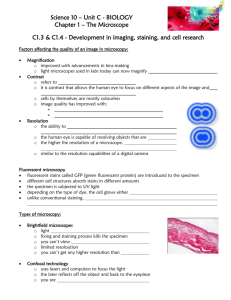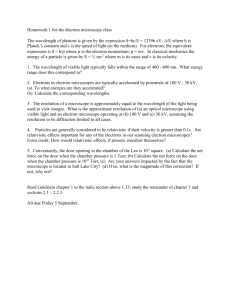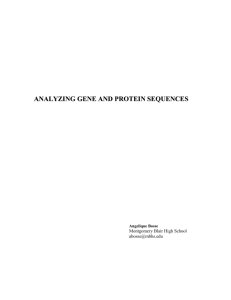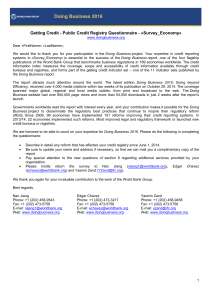Techniques involved in preparing specimens
advertisement
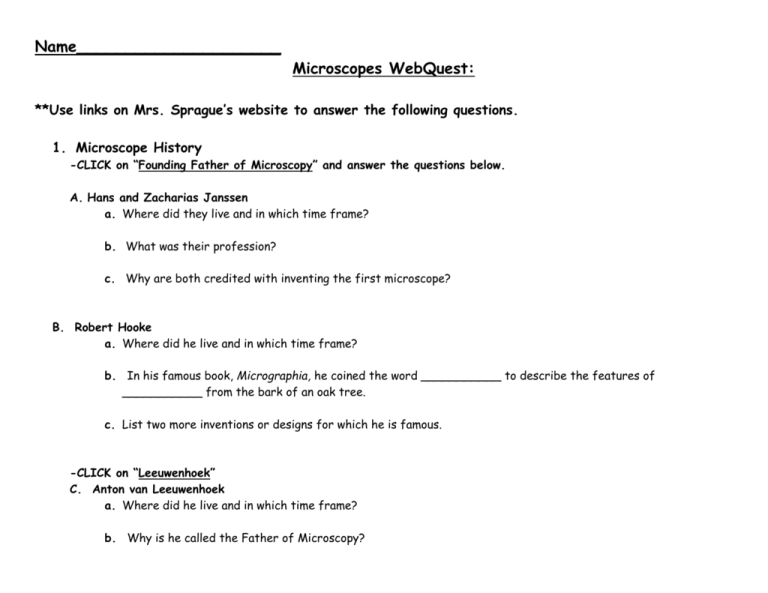
Name_____________________ Microscopes WebQuest: **Use links on Mrs. Sprague’s website to answer the following questions. 1. Microscope History -CLICK on “Founding Father of Microscopy” and answer the questions below. A. Hans and Zacharias Janssen a. Where did they live and in which time frame? b. What was their profession? c. Why are both credited with inventing the first microscope? B. Robert Hooke a. Where did he live and in which time frame? b. In his famous book, Micrographia, he coined the word ___________ to describe the features of ___________ from the bark of an oak tree. c. List two more inventions or designs for which he is famous. -CLICK on “Leeuwenhoek” C. Anton van Leeuwenhoek a. Where did he live and in which time frame? b. Why is he called the Father of Microscopy? c. Anton Van Leeuwenhoek was the first to see and describe ________________ , yeast plants, the teeming life in a __________________________, and the circulation of blood in ________________________. -CLICK on “History of Microscope Timeline” D. Other Inventors a. Who co-invented the first electron microscope? b. What year did this happen? c. List two other dates with the inventor names and invention. 2. Size and Scale: Slide the bar across the bottom of the graphic in order to see the different sizes of objects. a. Size of a grain of salt = __________________ b. Size of a skin cell = _____________________ c. Size of a X chromosome = _________________ d. Size of a measles virus = __________________ e. Size of hemoglobin = _____________________ f. Size of a water molecule = _________________ g. Scroll down to read under “Notes” and answer the following questions. i. ii. iii. iv. What is the smallest object size that can be seen by an unaided human eye? ___________________ What limits the magnification power of a light microscope? ________________________________ To view objects smaller than 500 nm, what do you have to use? _____________________________ T / F – Scientists are able to view molecules and individual atoms with powerful electron microscopes. 3. Types of Microscopes -CLICK on “Microscope Types #1-4” links in order to complete the table below. Feel free to click on additional links on any of these pages in order to fully research the different types of microscopes Type of Microscope Compound Light Dissection or Stereoscope SEM (scanning electron microscope) TEM (transmission electron microscope) How it works Magnification range Type of Image seen (live/dead, 3D/2D) Pros Cons 4. Click on “Virtual Digital Microscope” (Make sure your sound is OFF!) Try to correctly match all 10 SEM images at SEM Images. List your score out of 10 that you got correct. Which image was the most interesting? 5. Nanotechnology -CLICK on “Nanotechnology” a. Define Nanotechnology: b. What are three applications of nanotechnology? c. What are Atomic Force Microscopes and what are they used for? -Click on “Nanoworld Image Gallery” a. Click on “Artistically Modified” and name two of your favorite images. b. Click on “Scanning Electron Microscopy” and name two of your favorite images. c. Click on “Transmission Electron Microscopy” and name two of your favorite images. d. Click on “Light or Optical Microscopy” and name two of your favorite images.



